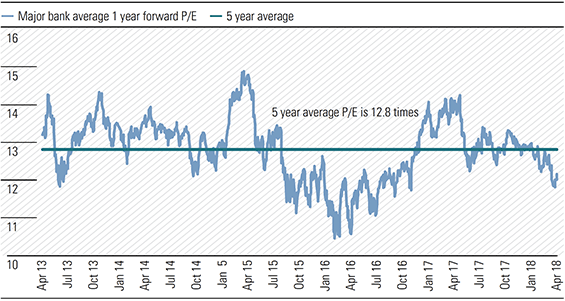Where to from here for Australia's wide moat major banks?
Despite all the negative press, the major banks continue to benefit from surprisingly solid fundamentals, delivering modest earnings growth, writes Morningstar's David Ellis.
The major banks seem to be operating in parallel universes. On the one hand it is all doom and gloom with investors facing a daily avalanche of negativity, including disturbing revelations from the Royal Commission, Productivity Commission reviews, ASIC inquiries, APRA capital changes, macro-prudential limits on lending and unfriendly policy proposals from the federal opposition to name a few. Not surprisingly, bank share prices have suffered.
On the other hand, Australian major banks continue to benefit from surprisingly solid fundamentals delivering modest earnings growth. Capital levels are strong, loan quality is pristine, the economy continues to chug along at a respectable 2-3% GDP rate, employment growth is strong, credit growth is solid, inflation is low, and the housing market is stabilising. Attractive fully-franked dividends are not under threat and capital returns are possible during the next few years. The risk of a recession in Australia remains low and surprisingly, the federal budget deficit appears to be shrinking faster than expected. This "Goldilocks" operating environment is good for banks and we see it persisting for several years at least.
The incessant news flow from sensationalist media and grandstanding politicians has weighed heavily on bank share prices, offering attractive entry points for investors. Westpac provides best upside, but all four major banks are undervalued relative to our fair value estimates. Investors should remain calm; current headwinds will dissipate after a difficult next 12 months and longer term we expect satisfactory shareholder returns, albeit lower than the stellar returns experienced during the past decade. Major bank forward price earnings ratios have contracted to an average of 12 times from 13 times five months ago and are now below long-term averages. Political and regulatory risks are still rising, but we believe current bank share prices broadly reflect these risks.
Exhibit 1: Major bank forward price to earnings (P/E) ratios
 Source: Thomson Reuters, Morningstar
Source: Thomson Reuters, MorningstarBanking is an industry Australia excels in
Make no mistake, banking is an industry Australia really excels in and the four major banks set a global benchmark. The major banks are world class for profitability and shareholder returns, though culture must improve. They boast impressive peer comparisons across operational efficiency, loan quality, risk management, returns on equity, capital levels and liquidity. Balance sheets and funding profiles are significantly stronger than pre-GFC levels and future earnings will withstand digital disruption. Strong fundamentals underpin the outlook for long-term earnings growth.
The major banks are both a strategic and economic necessity for Australia, playing a key role as importers of capital from international markets. Australia has long been unable to raise sufficient capital domestically to fund multi-decade economic expansion. Yet we are one of the wealthiest nations in the world with long-term wealth creation supported by a strong and profitable banking sector.
Geopolitical and economic risks are always present, but manageable
The main risk over the medium term is another global credit crisis, with flow-on implications for domestic lending, house prices, the economy and employment. A credit crisis would make it more difficult and costly for the banks to fund existing lending, creating a slump in lending growth and cause bad debts to rise. However, this is not our base case and in any event the banks have stronger financial positions than pre-GFC and can expect support from the government and the RBA in the event of a crisis.
Digital disruption from global tech giants such as Google, Apple, Amazon, Alibaba and Tencent as well as start-ups is a risk, but the major banks continue to invest heavily in product and service innovation to retain and grow customer numbers. Despite media and political commentary to the contrary, major bank customers trust their banks to protect their life savings and personal details from cyberattack. Customer trust is a key competitive advantage of the major banks.
The author's retirement fund owns shares in all four Australian major banks.

